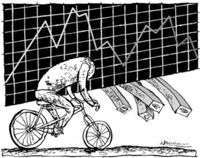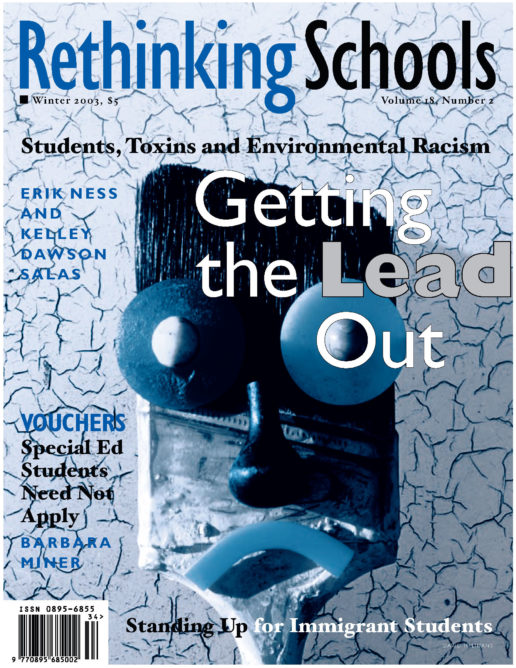Some Gaps Count More Than Others
Illustrator: Henrik Drescher

This year, AYPs are replacing the ABCs as the most important letters in many schools.
AYP, or “adequate yearly progress,” refers to the formulas that the No Child Left Behind Act (NCLB) uses to evaluate schools on the basis of standardized test scores. Under NCLB, all schools receiving federal funds are required to reach 100 percent passing rates for all student groups on state tests by the 2013-14 school year.
This underfunded and restrictive mandate is now the main preoccupation of districts and schools across the country. Yet the goal of equality in test scores contrasts sharply with the widespread inequality that is tolerated, even encouraged, by federal policy in many other areas. A look at such gaps sheds light on the hypocrisy at the core of NCLB.
But, first, how does AYP work? AYP is the rate of improvement schools must make on their state test scores to reach 100 percent within the allowed timeframe. Schools that don’t meet their AYP targets for any one of 10 student categories (total school population, special education students, limited English proficiency students, whites, African Americans, Asian/Pacific Islanders, Native Americans, Hispanics, other ethnicities, and economically disadvantaged students) face an escalating series of sanctions ranging from the loss of federal funds to possible closure or the imposition of private management on public schools.
Under AYP, the only thing that counts is the number of students who score above the passing level on the state test. So on a test like New Jersey’s High School Proficiency Assessment, where a passing score is 200, helping a bilingual, special education student from a low-income household raise his/her test score from, say, 50 to 199 counts for nothing. In fact, such a score counts as a failure in four different subgroups. Moving a student from 199 to 200 is success. This is just one example of the ridiculous ways NCLB uses state test scores as the sole measure of school and student progress.
Polls show that the U.S. public broadly supports the idea that federal policy should help reduce inequality in education, but it is largely uninformed about the specific impact NCLB will have on schools. [See Education Week, Sept 3, 2003.] This “information gap” is a reflection of a much deeper contradiction at the heart of the new law.
NCLB imposes a mandate on schools that is placed on no other institution in society. Imagine a federal law that declared that 100 percent of all citizens must have adequate health care in 12 years or sanctions will be imposed on doctors and hospitals. Or that all crime must be eliminated in 12 years or the local police department will face privatization.
Understandably, many educators are reluctant to oppose NCLB’s noble-sounding goals. But the AYP formulas and the “Leave No Child Behind” rhetoric of the new federal law are transparent attempts to set up schools to fail. When politicians like President Bush rail about the “soft bigotry of low expectations,” they effectively invoke concerns about historic inequities. But the real measure of their concern is what they propose to do about such inequality, not only in schools, but also in society at large. Here the record leaves little room for doubt: Inequality is as American as processed apple pie.
Take, for example, income inequality among some of the groups NCLB says must reach 100 percent test score equality within 12 years. Education research has established a strong link between student performance on standardized tests and family income. While income inequality in a community is no excuse for school failure, certainly any serious federal plan to close academic achievement gaps needs to concern itself with trends in closely related areas.
An AYP Income Analogy
But a look at the data on income inequality-especially through the prism of AYP-reveals the hypocrisy at the heart of the NCLB legislation. In 1991, the median household income for black families was about 58 percent of white income. Hispanic income was about 70 percent. (See table.) If we applied the “logic” of AYP to this key measure of how our economy works, the income gap for blacks would have had to narrow by 3.5 percent each year to pull even within 12 years-the same time frame schools have been given to equalize test scores. Hispanics, starting with a smaller gap, would have had to close the gap by 2.5 percent a year.
If you compare this to how the economy actually performed between 1991 and 2002, a period of supposedly unprecedented economic growth, you’ll find the U.S. economy would not have met its “AYP targets for income equality” for any year for either group. At the end of 12 years, the gap between black and white incomes had narrowed only a pitiful 3.7 percent; for Hispanics the gap was just .4 percent less than it was in 1991.
If we lived in an alternate universe where income equality really was a goal of federal economic policy, and an NCLB-like system of sanctions put pressure on the titans of industry and commerce to attain such a lofty goal, what might be appropriate remedies for such a dismal performance? “Corrective action?”-to borrow the language of NCLB sanctions. Economic restructuring? Reconstitution of our major corporations? How about “state takeover?”
The point, of course, is that there is no indicator of equality, including household income, child poverty rates, health-care coverage, home ownership, or school spending, where federal policy currently mandates equality among all population groups within 12 years under threat of sanctions-except standardized test scores in public schools. If this sounds unfair and absurd, it’s because it is. It’s a plan to use achievement gaps to label schools as failures, without providing the support and strategies needed to overcome them.
The AYP scheme and the resulting sanctions will do little to address the pressing needs of public schools. But they will create a widespread perception of systemic failure; demoralize educators, parents, and students; and erode the common ground that a universal system of public education needs to survive. It is a cynical campaign hatched by politicians who have built careers out of combining rhetorical concern for the victims of inequality with policies that perpetuate it.

